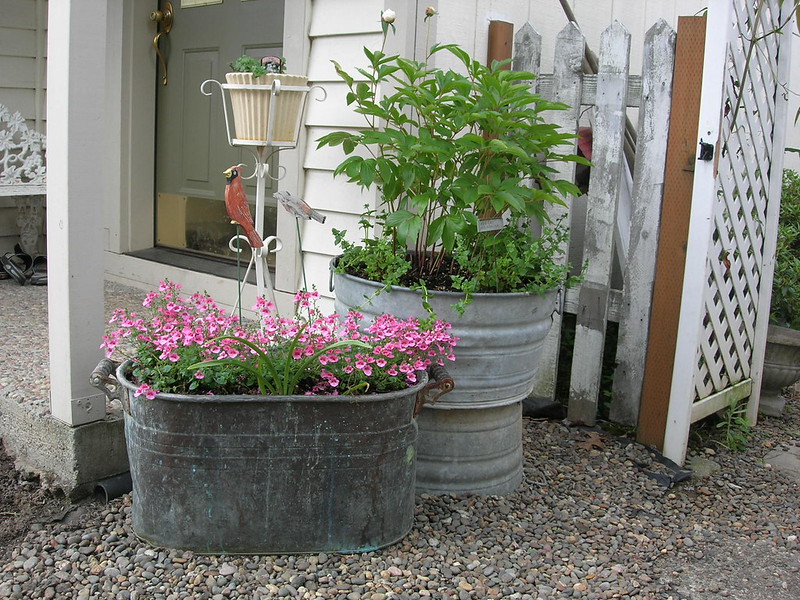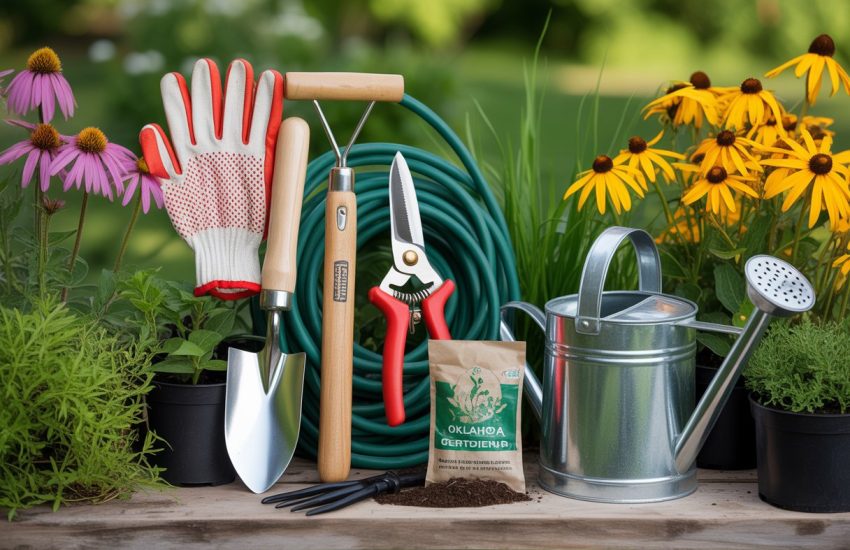Container gardening
What is container gardening? In its essence – it is the most convenient method of forming flower beds or other plant compositions in places where planting plants in open soil is limited or simply impossible. This technique allows you to grow herbs, vegetables, and flower crops, not only in the street but also in indoor conditions.
Due to the large variety of containers and crops that are used for such gardening, this option of growing is gaining in popularity. Container gardening is ideal for those who live in high-rise apartments without access to the outdoors or in houses with small yards. Let’s take a look at the general characteristics of container gardening, as well as its main benefits.

The Benefits of Container Gardening
A container garden opens up new possibilities in the selection of crops. For example, modern climatic conditions do not allow for growing lemon trees in open soil, but planting them in containers is a popular practice. This allows you to take the plants out into the garden for the summer and hide them inside after the winter season arrives. Growing outdoors will only benefit the crop.
Representatives with a long growing season develop in a similar way. With a short summer for a particular plant, the warm season can start earlier – in room conditions, where there are no threats of frost or snow in early spring. Container gardening gives plants a chance to grow indoors, where they don’t normally grow, to spruce up a room, balcony or patio. Also, a well-placed container can be the focal point of your garden.
Let’s take a closer look at the benefits of growing plants in containers.
- Saving space. If the size of the area to grow plants is minimal, then planting greenery, and other crops are carried out in containers, disposing of them on porches or balconies.
- Presentable appearance. The aesthetic side also makes container gardening attractive for growing on the plot
- Beautiful containers, placed next to the garden path, will create an attractive atmosphere in the area, making the garden plot neater and aesthetically attractive.
- Keeping it healthy. Container gardening is a good option for those who find it difficult to work the beds for health reasons or old age.
Large containers set on the ground, rising up to a meter or more in height, are easier to reach and less prone to weeds than a large lawn, no more weeding will be necessary, which will significantly save the health of your knees, and back.
The height of the ground cover in containerized containers will be optimal for your requirements, so you can do all the gardening work with pleasure. Minimal pests. This type of gardening ensures that there are no moles, shrews, or mice. This makes caring for your plants much easier.
See Also: Flower Garden In The Backyard
Growing Plants in a Container Garden
Container gardening is very suitable for people who want to try gardening but have limited space or limited time. It is also useful for gardeners who live in areas where the soil is not suitable for a particular plant. In order for container gardening to bear the desired fruits, you need to know a few features of this method of growing plants.
Availability of drainage
Drainage must be present in order for plants to fully develop and give a harvest. Therefore, it is better to buy containers immediately with made drainage holes. If there are none, then you need to make your own holes (diameter – 1 cm), and on the bottom lay stones or clay crocks. The key to a good result is an unobstructed escape of moisture. A container without holes is best used as a planter or outside the pot. You can grow your plants in regular pots placed in a decorative planter. Double-walled containers, pots, and hanging baskets are available now. This is a great option for small plants that need frequent watering.
The right containers
Today’s market offers a large variety of garden containers. But gardeners recommend giving preference to ceramic or wooden containers. They not only differ in naturalness but also are capable of quality absorbing excess moisture.
If you do not want to buy new containers, you can use old wooden barrels or crates. Do not forget about the size of the containers. It is also important to consider what kind of plants you want to grow in the container. Choose a large pot for mixed planting that will provide enough room for the roots of all the plants you want to grow. Also, remember that light-colored containers keep the soil cooler than dark ones.
Optimum soil composition
When choosing soil, you should pay attention to its level of breathability. If the roots lack adequate air flow, they may rot.
You can create a soil mixture of foam and leaf debris. Adding a little slow-soluble fertilizer is also recommended. This solution will minimize the effort in caring for the plantings. If you are going to grow plants that do not grow in your area, you need to buy the right soil mix for them.
Evaluate your sun
You can grow great container growers even if you have very little sun. You can grow spectacular container gardens if you’re soaked in sun all day (or something in between). However, for your container gardens to thrive, and even more impressively, you need to estimate exactly how much sunlight your pot or garden will deliver. And here’s a warning. If you’re just guessing, or think you know how much sunlight an area gets, odds are you’re wrong – a lot. No matter how good a gardener you are, you need greatly overestimate how much sun takes up an area.
The first thing you need to do is figure out, whether you time it with a clock or use a sun calculator, how much direct sunlight your containers will deliver. You need to do this close to the time of year you are going to plant because the sun is in a different place in the depths of winter than it is in summer. The amount of sun your pots get will determine what you can plant in them. You can’t know what will grow if you don’t know how much sun the plants get.
Select Plants
Once you’ve determined how much sun you have chosen your pot, and gotten your fill soil, now the fun part begins: choosing your plants. The first thing you want to do is look for plants that thrive in the same amount of sun as your pot. Most nurseries have plants with high sun requirements, and plants with shade usually have their own spot. However, there are tons of plants that are part sun or part shade.
So the good news is that regardless of your sun requirements, there will be plants that will be satisfied, now you just need to find them and decide. Also, if you are doing a mixed container, you want to make sure that all of the plants that you buy have not only the same light requirement but also the same water requirement.
There are many container design concepts, but the idea of using a “thriller, filler, and spill” approach is great for beginners. Also, don’t be afraid to put just one fabulous plant or multiple plants of the same variety in your pot.
Frequency of plantation watering
Container-grown plants require more frequent irrigation than groundcover plants. During times of active sunlight and windy weather, the soil dries out faster than usual. The frequency of watering will depend on – what plants you have planted in a pot, some like frequent watering, while others, for example, succulents, are not demanding of moisture.
Container garden plants need regular feeding. Fertilize them by watering them with appropriate supplements, and spraying the leaves with diluted preparations of these solutions.
Start by feeding every two weeks, and adjust the frequency depending on how the plants respond. To make large containers attractive, lay down a layer of mulch. This will also help retain moisture. Be sure to keep the mulch half an inch away from the plant’s stems.
Garden container care
Container plants, like any other plant, need regular care. You’ll probably want to give them special attention to keep them looking their best.
Remove ragged leaves and wilted flowers. Trim off plant offshoots that are too tall. To make mixed potted arrangements attractive – dig out or cut back any plants that don’t grow well or spoil the look. You can add something else or let other plants in the container fill the space. If your containers are in the garden – watch out for pests such as aphids and mites.
Why Container Gardening Might Make Sense For You?
There are many reasons why container gardening can make sense for you, including:
- You can control the soil mix, allowing you to grow plants that aren’t suited to your soil.
- Tropicals, succulents, and other specialized plants can easily be grown in containers.
- You can move containers around, effectively “remaking” your landscape whenever the mood strikes.
- Moving containers around also allow you to take advantage of moving sundials.
- Suitable plants can be moved indoors when the cold weather sets in.
Container gardening is easy, at least it can be. However, people often make the mistake of thinking, for example, that they can dump regular soil from an outdoor garden into a container to grow plants. In fact, it’s better to use a special potting mix in your containers rather than the garden soil you dig outdoors.
Conclusion
Growing plants in containers are probably the most versatile, interesting, and exotic way. Anyone can learn how to containerize in the garden. The use of containers cannot be random. Several options should be thought through by making a site plan. Compositions of well-chosen containers and the flowers in them can attract attention and create an accent.
Where should the containers be placed? Often they are only used to add greenery to the plot. But if your soul asks for coziness, then a great solution to the problem of decorating the site is mini-flowers in containers. With their help, you can decorate loggias, balconies, terraces, verandas, green restrooms, children’s corners, walking paths, the entrance to the site and the house, etc.
FAQ
Planting your container: How to do it?
When you have your plants, collected soil notes, and fertilizer, cover the bottom of the drainage hole with a plastic sieve, paper towel, or coffee filter so that your soil stays and water can escape. Fill the container with potting soil an inch or two on top.
Now mix in the fertilizer, carefully following the directions for quantities (this is especially important if you’re using regular fertilizer, which can burn your plants’ roots if you use it).
How many times to water container plants?
Depending on where you live and how hot it is, you may have to water a couple of times a day in the heart of summer, especially if your pot is small.
3. How to choose a container for container gardening?
When choosing a container, make sure it has adequate drainage or that you can add drainage holes. Have at least a one-inch hole in a large container (ish). If you don’t have enough drainage, depending on what your pot or container is made of, you can usually drill, punch or score additional holes.
Self-draining pots are great because they water plants, usually using a reservoir system that also gives great latitude.

